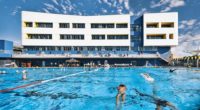Inglewood, California
Above the door to every classroom at 'nimo Leadership Charter High School, in Inglewood, California, a glowing green sign reads: The Road to College Starts Here. Though the student population is mostly low-income, and the school occupies a tough site'near the 105 Freeway and the approach to Los Angeles International Airport'this is a place of soaring aspirations.
Yet when Petruzzi, a self-described architecture buff, approached various firms to design the 28-classroom 'nimo Leadership school, he got disheartening responses. Given the tight (30,300-square-foot) site, budgetary restrictions, and low-rise residential neighbors, 'everyone said we could just do a 'shoebox' for classrooms, with a stair at either end. Period,' he recalls. 'They told us to forget about casual 'hangout' spaces, or even a lunch area.'
But Los Angeles'based Brooks + Scarpa Architects (BSA) had a different idea'and it dovetailed with Petruzzi's ambitions to reverse the downward spiral of a rough neighborhood while providing a model of energy efficiency.
Certified by CA-CHPS (the environmentally focused California Collaborative for High Performance Schools), the 50,165-square-foot building BSA realized opens up the site at its core. Though the three-story structure is built out to the edges of its urban corner site, it ushers light and air into its center with a funnel-like courtyard, oriented to optimize passive shading and draw through-breezes. This outdoor room doubles as the lunch area, assembly hall, and prime mingling zone. Concrete stadium steps at one end serve as an amphitheater or perches for gatherings. 'We wanted the five minutes between classes to be an important part of the experience,' says BSA principal Larry Scarpa. 'We actually created more stairways than required, to increase meet-up opportunities.' Within this building'clad in white-pigmented cement plaster'wide open-air corridors embrace the temperate climate.
BSA sheathed the long south-facing front facade in nearly 500 PV panels. The feature's $688,000 price tag may seem like a big chunk of the building's $15.2 million cost. But Petruzzi says favorable financing made the array feasible and beneficial'in both the short- and long-term. As he explains, California Proposition 55, the Kindergarten'University Public Education Facilities Bond Act of 2004, covered half the project costs and gave Green Dot a long-term, low-interest loan for the remainder. With the PVs meeting 75 percent of the school's energy needs, Scarpa estimates an annual savings of $70,000. So, payback for the apparatus is modest and gradual, while the impact on operating costs is substantial.
'nimo Leadership's other material components are humble: concrete floors, white-pigmented cement-plaster outer walls, exposed ductwork in classrooms, and white-painted metal railings and mesh along the staircases and the broad, single-loaded corridors. The building's tight V-plan'like a solid block with a jagged, converging chasm of circulation cut through it'invites views and social interaction across the central open space.
The building opened in 2012, and, so far, the results are encouraging. The school (begun in temporary quarters in 2000) currently boasts college admissions for 98 percent of its graduating class, with many the first in their families to achieve higher education. In 2013, Newsweek ranked it among the nation's 2,000 most effective public schools for producing college-ready graduates'and one of the country's 'Top 25 Transformative High Schools' (or 'game-changers' for youth below the federal poverty line).
But, like any ambitious undertaking, it has met bumps in the road. The gym BSA designed for a separate site nearby is not yet under construction. (The school has improvised by leasing local parks, playing fields, and gyms, and has already succeeded in winning some state championships.)
Among the features value-engineered out was courtyard landscaping. And the public art intended for the building's base'a mural to be painted with student participation'has not yet taken form. For the grand opening and photos shown here, BSA temporarily installed a mural of its own design. Without it, the entry area is currently a bit drab. But the litmus test: students seem to be thriving. On a recent visit, a small group of them worked intently after hours with a teacher in a chemistry lab. And after school lets out, they can be spotted throughout the neighborhood (most live within walking distance) proudly sporting their 'nimo Leadership sweatshirts.
'Larry Scarpa captured the essence of what we wanted,' says Petruzzi, 'a sense of openness and connection with the surrounding community, even on such a compact site. When everyone else said, 'Forget it,' we didn't give up.'
PeopleClient: Green Dot Public Schools Owner: Green Dot Public Schools
Architect:
Personnel in architect's firm who should receive special credit: Architect of record: same
Engineers: Civil: Barbara L. Hall, P.E., Inc. MEP: E2DI
Consultant(s): Acoustical: Newson Brown Construction Manager: Telacu
Photographer(s): Size: 50,164 square feet Total construction cost: $15.3 million Completion date: June 2012 |
Products
Structural system Metal: Natural oxidized cold rolled recycled steel Concrete: Type ll Portland Cement with 25% flyash, LM Scofield Lithochrome stain
Exterior cladding Masonry: Generic Concrete Masonry Unit – 8” reinforced Metal Panels: IC72 18-gauge Corrugated metal panel Metal/glass curtain wall: US Aluminum Moisture barrier: #15 Building Paper Curtain wall: US Alum.
Roofing
Windows
Glazing Skylights: Bristolite, Solatube International, Inc
Doors Metal doors: Carrier
Hardware Closers: McKinney, Sargent Exit devices: McKinney, Sargent Pulls: McKinney, Sargent
Interior finishes Suspension grid: USG – Donn Suspension System Exterior Ceiling: USG PARALINE® Linear Metal Ceiling System Demountable partitions: Operable partition by Modernfold Cabinetwork and custom woodwork: ISEC Inc. Paints: Non-toxic zero VOC Paints by AFM Safecoat Wall coverings: tackboards by Claridge. Acoustic panels by LBI Boyd Solid surfacing: ISEC Inc., Omnideck by Bradley Floor and wall tile: Ecotile by Walker Zanger in bathroom Carpet: HllyTex, Inc.
Furnishings Reception furniture: Custom Millworks
Lighting Downlights: Capri, Halo Exterior: Halo
Conveyance
Plumbing
Energy
Other unique products that contribute to sustainability:
Add any additional building components or special equipment that made a significant contribution to this project: |












Post a comment to this article
Report Abusive Comment